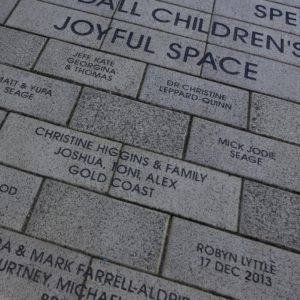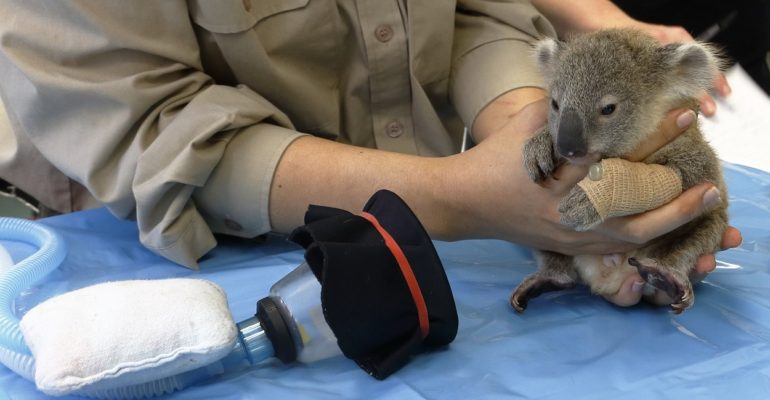
A young koala joey named Flip gets emergency treatment at Currumbin Wildlife Hospital on the Gold Coast
Currumbin Wildlife Hospital treats more than 9,000 wild animals every year, most of them injured due to human impact such as habitat loss, domestic pet attacks, vehicle hits, and getting caught in fishing tackle.
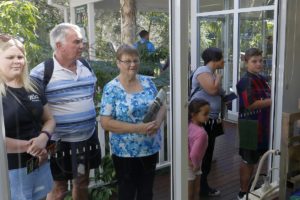
The Wildlife Hospital is part of the Currumbin Wildlife Sanctuary, one of the Gold Coast’s major tourist attractions. Both the Sanctuary and the Wildlife Hospital are owned and operated by the National Trust of Australia (Queensland). Currumbin Wildlife Hospital is funded through the Currumbin Wildlife Hospital Foundation.
Visitors to the Wildlife Sanctuary can view some of the Hospital’s activities through large windows.
Redlands2030 visited the hospital and interviewed Senior Veterinarian, Dr Michael Pyne. Here’s what we saw and learnt.
Currumbin Wildlife Hospital is getting busier
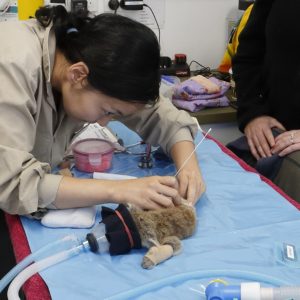
R2030 Thank you for allowing Redlands 2030 behind the scenes to see your wildlife hospital as I know you’re extremely busy – especially when you have a fresh emergency case just brought in.
Yes, you’re just in time. Little Flip, a koala joey has just come in. Found late last night in Northern Rivers and has been brought in by Friends of the Koalas. He has a high fracture on his arm, no mother and probably been on his own for two days as there’s no food in his stomach. He’s anaesthetised while we do a thorough check over him and put a splint on his arm. Flip will have x-rays, ultrasound, blood tests and is now being swabbed to check for a range of diseases.
R2030 What are Flip’s chances for survival?
Slim. He’s about seven months old and really struggling but we have seen worse and they have survived. Flip will be sent home with Friends of the Koalas for rehabilitation and care. They do a lot of great work for koalas. It was a miracle he was seen that late at night on a country road. He’s very lucky that people not only spotted him but stopped to save him.
See end of this story for an update on Flip
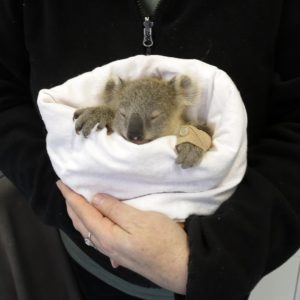
R2030 Do private vets treat wildlife or only wildlife hospitals?
Some private veterinary clinics do a great job treating wildlife but in general it can be difficult for them to manage treating wild animal around their pet clients. We are fortunate to have our Wildlife Hospital designed to treat wildlife.
R2030 What other wildlife do you treat?
We see them all, heaps of birds including birds of prey, wide range of mammals and of course reptiles of all sorts Come October we will be bursting at the seams. Everything happens, it’s breeding time. Last year we treated 9,615 animals. We’re currently 10% up on last year.
R2030 How many of these patients are koalas?
In 2007 we admitted just 28 koalas for the year Just ten years later in 2016 we admitted over 400. Much of the increase is due to the growing level of disease amongst our wild koala population. Chlamydia plays a major role. We’re seeing 80% of our koala admittances now have chlamydia. I feel there is also a level of our public being more aware of wildlife and that more can be done to help wildlife and are prepared to take injured and sick wildlife to Wildlife Hospital and vet clinics.. Of course habitat loss also plays a major role.
Redlands is an area with a lot of pressure on the habitat.
Koala disease and vacines
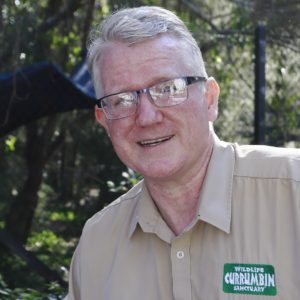
R2030 What is chlamydia and what causes it?
Chlamydia is a bacterial disease of koalas that can affect the eyes, respiratory tract and the urinary and reproductive tract. If we can get the sick koalas early before the infection spreads to their important organs it is a very treatable disease. The treatment is a minimum four weeks of antibiotics but often treatment will last for 8-12 weeks. Sadly koalas where the infection has spread to their kidneys can often be very difficult to save.
R2030 Is the chlamydia vaccine working?
The chlamydia vaccine is showing promise and certainly proving to provide a level of protection against the disease. Of course much more work needs to be done to show how long the immunity from getting the vaccine can last and how it can help already diseased koalas. The hope is that eventually we can work towards vaccinating every koala that comes through the Wildlife Hospitals.
R2030 So you’re saying the most important thing for koalas right now is vaccines?
Yes. Disease is a major killer of koalas, We badly need more funding for research and vaccines. Retrovirus leaves koalas more susceptible to infectious diseases. It’s a relatively new disease which can be passed directly from parent to offspring and between koalas.
R2030 What other issues are there for koalas that vets see need support besides vaccines?
Where koala areas have disappeared, we need to look at relocating. The problem is we can’t move koalas that come from a diseased area to a non-diseased area. Pockets are not ideal. Landlocked areas are not realistic. We need good land, done properly and done well. There’s good areas out there and it would be wonderful to have them set aside for our koalas.
Rehabilitation and care of wildlife
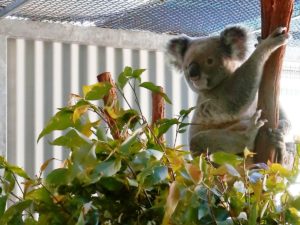
R2030 If koalas can’t go from a wildlife hospital back into the wild, where do they go?
We have a rehabilitation area here but we need a lot more. The gap is in care centres. There’s a shortage of koala post-op care places and if people could provide areas for rehabilitation it would take a lot of pressure off us. That would allow vets to concentrate on what vets are good at, saving lives.
R2030 What’s required to set up a care centre?
Not a lot really. Ideally you need two acres. It would require a person to manage the volunteers and paperwork and getting food to the koalas as they would need to remain in enclosures until released back into the wild. If people want to gift us a piece of land it would be fantastic as that’s the major cost. The National Trust is very supportive with volunteer training.
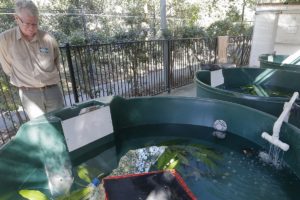
R2030 Where are the koala care centres needed?
Often koalas do need rehabilitation post treatment to prepare for release into the wild. Ideally it would be great to have the space to have predator proof fenced areas for long term koalas to exercise and regain their strength in preparation for release. On average they’re in care for about three months before being released back in the wild.
R2030 Do you have any koalas in care at the moment that could go to carers?
This is our quiet time so we are okay to look after a few. Blinky over here has chlamydia and can’t open his eyes so he’s on antibiotics and food is brought to him. Over here in enclosure 3 we have Biddy and Buttons. They were brought in yesterday. Buttons was caught upside down in the fork of a tree and Mum was in a very distressed state. They have both had a detailed check over and Buttons has received intravenous fluids and pain relief. We’re just letting them rest now. She’s a great mum and has the joey snuggled in her pouch. She seems a lot more relaxed today. it’s important she has rest and minimal human contact. As I said, come spring time every one of these enclosures will be bursting at the seams.
Funding and support for Currumbin Wildlife Hospital
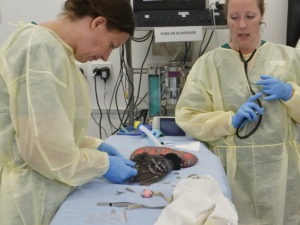
R2030 How are you funded for the wildlife hospital and all the people who work here?
We’re very fortunate to have a strong roster of around 120 dedicated volunteers, and 45 students training to become veterinary nurses. We’re also very fortunate to be with the National Trust so we have a successful staff recruitment strategy. We rely completely on funding from grants and community and government donations. We have two vets on staff and a third in the busy months as well as four nurses and administration staff.
R2030 You haven’t mentioned how you fund capital expenditure?
There’s no resources for capital expenditure so the structures and fit outs have been built from donations and grants. The generosity of individuals, businesses and funding through grants has allowed us to build a great set of enclosure for wildlife over the past 10 years.
R2030 You have Hospital Hero’s. Tell us what this means and why so important?
We have Buy a Tree for $10 which is planted in our plantation and provides food for sick koalas for 15 years. There’s also our pavers which are seen by all visitors and tourists. You get to have a message placed and can come and view anytime. They’re $90 and $350 for business logos. We are always looking for more funding to further expand the work we do in caring for our native wildlife.
R2030 Does the Gold Coast Council support your mission?
Yes, they’re very supportive. They have a good team that organise community consultation, family days with council for wildlife education and give information back to koala groups with mapping koala management areas. It’s providing a holistic approach. A number of the councillors have supported us financially through their divisional funding.
R2030 So a lot of people put a lot of effort into saving koalas?
If we can’t be bothered to save koalas then what can we be bothered to save?
Update on Flip
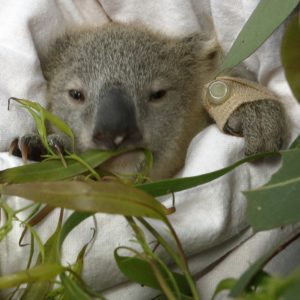
Flip was brought into Currumbin Wildlife Hospital on 6 July 2017, more than ten weeks ago.
We know that lots of people will be wondering if he survived.
Before publishing this story we checked with Friends of the Koalas and were delighted to hear that Flip is alive and doing well with his wildlife carer.
Redlands2030 – 19 September 2017
Please note: Offensive or off-topic comments will be deleted. If offended by any published comment please email thereporter@redlands2030.net
